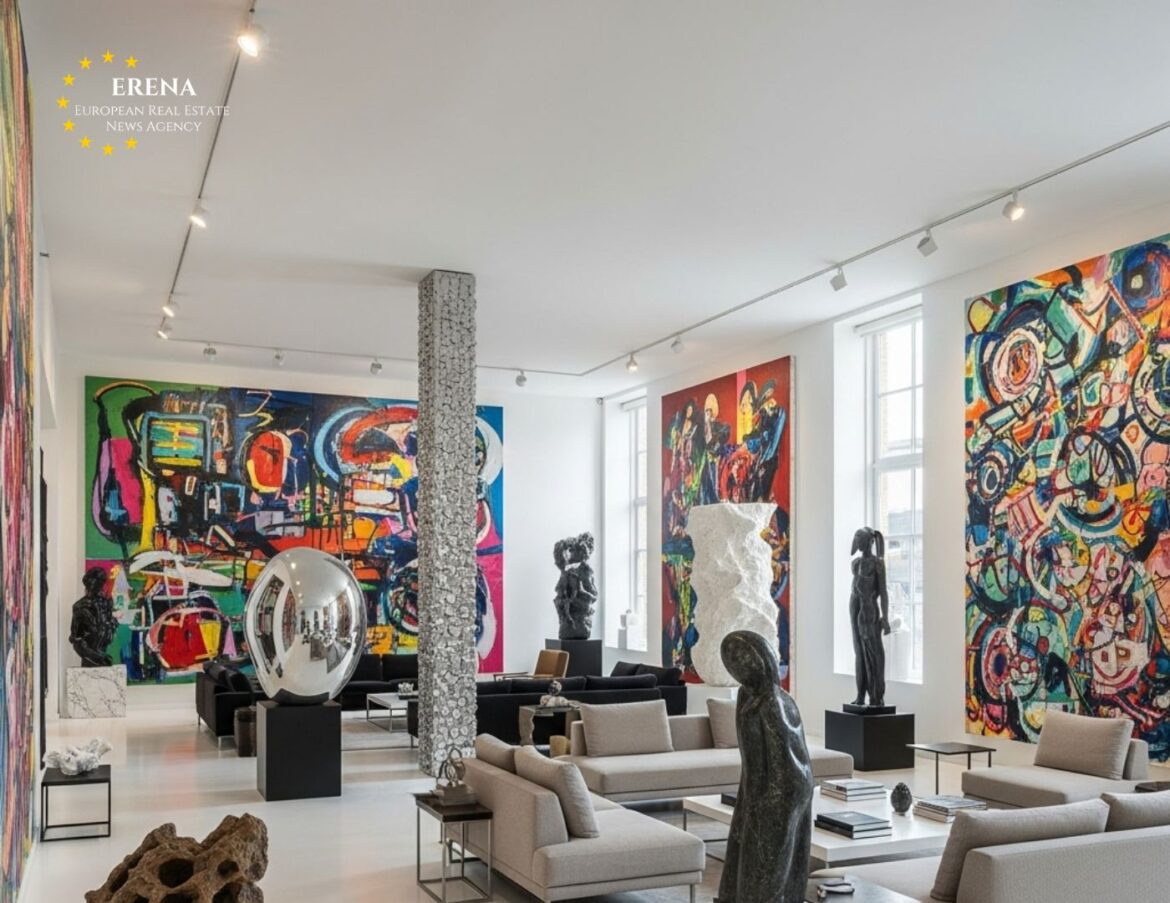Modern living spaces are evolving beyond functionality to become reflections of personal identity. One of the most striking trends in contemporary interior design is the transformation of apartments into full-fledged art galleries. In these homes, paintings, sculptures, and installations do not merely decorate the walls—they are the walls. Art becomes an architectural element, redefining how we divide space, express ourselves, and experience our surroundings. But what drives this trend, and what are its implications in terms of design, usability, and emotional resonance?
Art as a Structural Element
The traditional divide between “interior design” and “art” is disappearing. Homeowners, collectors, and even renters are choosing to integrate artworks into the very fabric of their homes. Large-scale canvases, murals, and digital installations can replace partitions or define spaces entirely. The result: apartments that function as dynamic exhibitions where every corner has aesthetic or cultural meaning.
Viennese designer Elisabeth Spiegel notes:
“Today’s clients don’t just want a stylish kitchen or bathroom—they want interiors that tell their story through visual language. For one client, it’s a collection of African ceramics; for another, it’s a hanging sculpture that conceals the wardrobe.”
Why Is This Trend Growing?
- Personal expression – In an era of mass production, art allows people to create unique, deeply personal environments.
- Visual richness – Urban life is saturated with commercial imagery. At home, people crave meaningful, inspiring visuals.
- Art as investment – Increasingly, art is seen not only as decoration but as a financial asset.
- Integration of digital solutions – LED screens, projections, and NFT displays enable flexible, changeable “walls” of art.
Examples of Art Integration in Residential Interiors
- Paintings as partitions – In the Paris apartment of gallerist Olivier Berger, the bedroom is separated from the living room by a 3×2 meter painting that rotates on a hinge. It replaces a wall and sets the tone for the entire space.
- Sculptures as architecture – In a Berlin loft, the entrance area is defined by six concrete sculptures by a local artist, forming a physical and visual barrier.
- Digital walls – In London, designer Jason Miller created an apartment with a full-height 8K screen along a load-bearing wall. The screen continuously displays rotating digital artworks purchased as NFTs.
The Balance Between Art and Function
When art replaces walls, the challenge is not only aesthetic but practical. Designers must consider acoustics, lighting, climate, and privacy. A glass installation separating the bedroom and bathroom, for instance, may look stunning but requires soft night lighting to avoid discomfort. A canvas used in place of a door should offer adequate sound insulation.
Milanese architect Fabio Conti comments:
“An art-filled apartment is not just a place with a Monet over the couch. It’s a place where the artwork interacts with daylight, the furniture, and the movement of people throughout the day.”
The Psychology of Living With Art
Integrating real art into the living space has a powerful emotional effect. It can make a space feel larger, richer in meaning, and more connected to culture. Studies show that living among art can enhance mood, reduce stress, and boost creativity.
A 2023 study by the Copenhagen Institute of Urbanism found that residents of apartments featuring regularly changing artworks were 22% more likely to report high levels of satisfaction and comfort in their homes than those without integrated art.
Economic Impact and Market Value
Apartments that incorporate art structurally or conceptually tend to command higher prices and rental rates. According to a report by the French real estate agency L’Habitat d’Art, such properties rent for 15–20% more than comparable units thanks to their uniqueness and visual appeal.
In Barcelona, for instance, a 90 m² apartment filled with installations by Catalan artists sold for €690,000—€120,000 more than a nearly identical unit in the same building without artistic integration.
Practical Tips for Homeowners
- Start with one area – Consider incorporating art into the hallway or kitchen before transforming the entire space.
- Collaborate with artists – Commissioning work from emerging talents can be more affordable and deeply personal.
- Mind the environment – Light, humidity, and temperature all impact how artworks age.
- Use digital tools – LED panels and projectors allow flexible displays without permanent installations.
- Document everything – If an artwork becomes a structural element, ensure it is included in architectural and legal documentation.
Interview: A Collector’s Perspective
Anna Levenson, owner of an art-integrated apartment in Tel Aviv:
“I was tired of plain white walls. I wanted to live inside an exhibition—a space where every corner inspired me and told a story. We don’t even have a TV. Instead, we have a large painting by a local artist that separates the kitchen and living room. It’s beautiful, functional, and says a lot about our values.”
A New Standard in Urban Living
This “apartment-as-gallery” model is gaining traction in major cities across Europe and Asia. Developers in Berlin, Zurich, and Seoul are designing residential units with built-in display niches, lighting systems, and rotating walls for curated exhibits. It’s quickly becoming a feature of premium real estate.
In Lisbon, the agency Art Living Portugal promotes the concept of “living art,” offering interiors designed as rotating exhibitions. Buyers can even subscribe to an annual art rotation program featuring works by local artists.
Conclusion
Turning an apartment into a gallery is more than a design statement—it’s a reflection of evolving cultural values and personal priorities. When art replaces walls, the home becomes a space of identity, emotion, and inspiration. While it demands careful balance between function and form, such environments offer far more than beauty—they offer soul.

